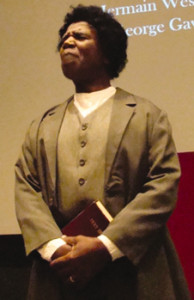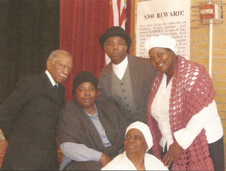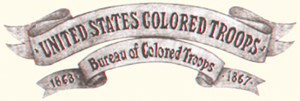Harry Bradshaw Matthews, United States Colored Troops Institute, Hartwick College, Oneonta
3rd Regiment Infantry, United States Colored Troops, Philadelphia, Pa.
Robert Djed Snead portrays Rev. Jermain Wesley Loguen at induction of Loguen to National Abolition Hall of Fame and Museum 2011.
AKWAABA: The Heritage Associates of Rochester NY will perform a play in response to Frederick Douglass’ call “Men of Color: To Arms!”
(Peterboro, NY – May 2013) With the issuance of the Emancipation




 Proclamation Jan. 1, 1863, President Abraham Lincoln authorized the recruiting
of African American soldiers in the Union Army. The 21st annual
Peterboro Civil War Weekend will observe the Sesquicentennial of the
United States Colored Troops with programs during the annual event
Saturday, June 8, and Sunday, June 9.
Proclamation Jan. 1, 1863, President Abraham Lincoln authorized the recruiting
of African American soldiers in the Union Army. The 21st annual
Peterboro Civil War Weekend will observe the Sesquicentennial of the
United States Colored Troops with programs during the annual event
Saturday, June 8, and Sunday, June 9.The United States Colored Troop Institute at Hartwick College, Oneonta, will set up an exhibit from its Images of the Freedom Journey collection at the Smithfield Community Center Saturday, June 8, from 10 a.m. to 5 p.m. The displays will include prints, books, and photos of abolitionists who contributed to the ending of slavery.
The USCT Institute is designated by the National Park Services as a research center of the National Underground Railroad Network to Freedom. Matthews and the USCTI have been honored by numerous proclamations in several states and by the Congressional Black Caucus’ Military Braintrust for outstanding African American genealogical and historical research.
At 12:30 p.m. June 8 at the USCTI exhibit, Harry Bradshaw Matthews will present “The Meaning of Colored.” Matthews is the founding president of the United States Colored Troops Institute for Local History and Family Research at Hartwick College and the associate dean and director of the U.S. Pluralism Center at Hartwick.”
Matthews was placed in the C-SPAN Video Library for being the keynote speaker at the USCT Grave Site Salute at the Gettysburg National Cemetery during the 2008 Commemorative of Lincoln’s Gettysburg Address. Matthews was also a featured speaker at the 2010 USCT Grand Review in Harrisburg, Pa. He is the grandson of the formerly enslaved Richard Parler, Jr. of Denmark, S.C.
On Sunday, June 9, the 3rd Regiment Infantry, United States Colored Troops (re-enacting) will exhibit in the East Tent. The 3rd Regiment USCT is a non-profit, 501c3 charitable organization from the Philadelphia, Pa., area. The mission of the unit is to educate the masses in the history and service of the United States Colored Troops.
The 3rd Regiment provides services to youth in scouting, supports senior citizens and helps the needy. The Regiment supports the creation of a United States Colored Troops Memorial Monument and Its Maintenance. The group participates in Living History presentations and battle reenactments. The 3rd will present programs at its exhibit site:
* At 10:30 a.m. the 3rd U.S. Colored Infantry Regiment will open the programs Sunday, June 9, of the 21st Annual Peterboro Civil War Weekend with the reenactment of a graveyard ceremony at the Civil War statue on the green in Peterboro where the weekend encampment is located. Color guard, rifle salutes, taps, historical narrative, singing, military instruments, public participation and the presentation of 34-star flags (the flags of 1863, the year of Emancipation) will be part of the ceremony to honor the African American Civil War veterans from Peterboro.
These veterans will be represented by family and others during the ceremony according to records of Donna Dorrance Burdick, Smithfield town historian.
* At 1:30 p.m. Joseph Becton, Private 3rd US Colored Infantry (reenactor), historian, impressionist, co-founder of the 3rd US Colored Infantry, and owner/operator of Joe Becton’s Tours will present a Soldier’s Life as a Colored Troop. The program is an informative and inspirational demonstration, exhibit, and presentation on a Civil War soldier’s life.
This educational and interactive program describes the participation of African Americans in the Civil War 1861-1865. Becton uses an array of techniques to tell the story that concentrates on identifying the reasons for the war, conditions of camp life, demonstrating the equipment and explaining that war is not good. Becton also includes a poem or song.
* At 3:45 p.m., Becton joins with others from the 3rd US Colored Troop Regiment to present Music of the Civil War Era. During the one hour interactive musical program the group will interpret music from Francis Johnson to Julia Ward Howe – the 1830s to the 1860s.
The unit members perform styles including spirituals, Underground Railroad songs, and camp songs on guitar, flute, harmonica and voice. Each song will be accompanied by a story which frames the song in its historic context.
Group participation will be encouraged.
Rev. Jermain Wesley Loguen, Syracuse abolitionist, Underground Railroad stationmaster and owner of property on the green in Peterboro from 1846-51 will return to Peterboro to recruit African-American men to serve in the new U.S. Colored Troops. Loguen will walk the encampment persuading enlistment; at 11:30 a.m., he will give one of his 1863 recruitment addresses to encourage black men to join the United States Colored Troops.
Loguen will tell of the struggle for the right to serve in the military and will share correspondence between sweethearts Lewis Douglass (Frederick Douglass’ son serving in the war) and Amelia Loguen (Loguen’s daughter).
Loguen will be portrayed by Robert Djed Snead, a graduate of Monroe Community College and Brockport State University. Snead has studied and portrayed Loguen for several years. Snead performed for the induction of Loguen to the National Abolition Hall of Fame and Museum in Peterboro.
At 12:30 p.m., the program “Frederick Douglass: Men of Color, To Arms!” will be presented by AKWAABA.
This playlet begins in the Frederick and Anna Douglass family home, where parents and sons discuss their father’s “Men of Color, to Arms!” command. Excited that two of the sons will soon depart for duty with the 54th Massachusetts Infantry Regiment, all are sobered at recall of the casualties already experienced in their family. It is a situation that robbed them of a daughter and two close anti-slavery allies.
Admission for the 21st Annual Peterboro Civil War Weekend covers event activities (except shopping and food). $7 Adults, $3 ages 6 – 12, Free under 6. For more information, visit civilwarweekend.sca-peterboro.org, call 315.280.8828 or email mail@sca-peterboro.org.

